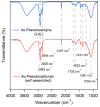Overview of the Metallization Approaches for Carbyne-Based Devices
- PMID: 37687238
- PMCID: PMC10489634
- DOI: 10.3390/molecules28176409
Overview of the Metallization Approaches for Carbyne-Based Devices
Abstract
Metallization for contacts in organic electronic nanodevices is of great importance for their performance. A lot of effects can appear at the contact/organic interface and modify the contact parameters, such as contact resistance, adhesive strength, and bonding ability. For novel materials, it is important to study the interactions with metal atoms to develop a suitable technology for contacts, fulfilling to the greatest extent the above-mentioned parameters. A novel material is carbyne, which is still under intensive research because of its great potential in electronics, especially for sensing applications. However, the most appropriate metallization strategy for carbyne-based devices is still unknown, so the interactions between carbyne and metal films should be studied to more precisely direct the development of the metallization technology, and to form contacts that are not limiting factors for device performance.
Keywords: carbon chain; carbyne; electrical contact; metal interface; metallization.
Conflict of interest statement
The authors declare no conflict of interest.
Figures

















References
-
- Jayan K.D., Sebastian V. Comprehensive device modelling and performance analysis of MASnI3 based perovskite solar cells with diverse ETM, HTM and back metal contacts. Sol. Energy. 2021;217:40–48. doi: 10.1016/j.solener.2021.01.058. - DOI
-
- Taleghani N.M., Heydari Z., Madani M., Nasiri A.F., Kolahdouz M., Abdy H. Study of metal-Co/Zn-doped CuSCN contacts for efficient hole transport in perovskite solar cells. Opt. Mater. 2022;133:113009. doi: 10.1016/j.optmat.2022.113009. - DOI
-
- Xie F., Yang M., Jiang M., Huang X.-J., Liu W.-Q., Xie P.-H. Carbon-based nanomaterials—A promising electrochemical sensor toward persistent toxic substance. TrAC Trends Anal. Chem. 2019;119:115624. doi: 10.1016/j.trac.2019.115624. - DOI
-
- Nath B., Singh S., Behera S.K., Ramamurthy P.C., Mahapatra D.R., Hegde G. Perovskite solar cell performance analysis via interface engineering employing MOF-composite. Sol. Energy. 2023;257:249–256. doi: 10.1016/j.solener.2023.04.035. - DOI
Publication types
Grants and funding
LinkOut - more resources
Full Text Sources

